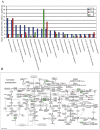Metabolomics reveals metabolic biomarkers of Crohn's disease
- PMID: 19636438
- PMCID: PMC2713417
- DOI: 10.1371/journal.pone.0006386
Metabolomics reveals metabolic biomarkers of Crohn's disease
Abstract
The causes and etiology of Crohn's disease (CD) are currently unknown although both host genetics and environmental factors play a role. Here we used non-targeted metabolic profiling to determine the contribution of metabolites produced by the gut microbiota towards disease status of the host. Ion Cyclotron Resonance Fourier Transform Mass Spectrometry (ICR-FT/MS) was used to discern the masses of thousands of metabolites in fecal samples collected from 17 identical twin pairs, including healthy individuals and those with CD. Pathways with differentiating metabolites included those involved in the metabolism and or synthesis of amino acids, fatty acids, bile acids and arachidonic acid. Several metabolites were positively or negatively correlated to the disease phenotype and to specific microbes previously characterized in the same samples. Our data reveal novel differentiating metabolites for CD that may provide diagnostic biomarkers and/or monitoring tools as well as insight into potential targets for disease therapy and prevention.
Conflict of interest statement
Figures




References
-
- Sartor RB. Mechanisms of disease: Pathogenesis of Crohn's disease and ulcerative colitis. Nature Clin Practice Gastroenterol & Hepatology. 2006;3:390–407. - PubMed
-
- Willing B, Halfvarson J, Dicksved J, Rosenquist M, Jarnerot G, et al. Twin studies reveal specific imbalances in the mucosa-associated microbiota of patients with ileal Crohn's disease. Inflamm Bowel Dis. 2009;15:653–660. - PubMed
-
- Nicholson JK, Holmes E, Wilson ID. Gut microorganisms, mammalian metabolism and personalized health care. Nature Rev Microbiol. 2005;3:431–438. - PubMed
Publication types
MeSH terms
Substances
LinkOut - more resources
Full Text Sources
Other Literature Sources
Medical

